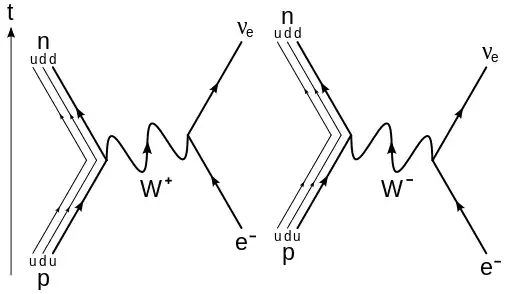In electron capture, when looking at the Feynmann diagram, I'd interpret the interaction as the electron emitting a W boson which interacts with the proton and turning into a neutrino. However, as the W boson is a virtual particle, there would be no reason why the electron would turn into a lower-energy particle. So then I read that the electron is "absorbed" by the proton, which would make a bit more sense, but I still don't get how an electron can just be absorbed. Does it turn into energy? And where would the energy that seems to be deleted go? Because an electron has much more energy than a neutrino...
2 Answers
In electron capture, the system "electron plus proton" is transformed via the weak charged current into the system "neutrino plus neutron.". For an isolated proton and electron, such as in a hydrogen atom, this transformation is energetically prohibited. But in a heavy nucleus with $Z$ protons and $N$ neutrons, the nearby nucleus with $Z-1$ protons and $N+1$ neutrons may have lower overall mass due to nuclear interactions. It is these proton-rich / neutron-deficient isotopes which can decay by electron capture. The released energy comes from the nuclear interaction.
- 96,301
The Feynman diagram for electron capture would typically be drawn as something like this:
and it does look as though an electron absorbs a $\mathrm{W}^+$ and turns into a neutrino, or alternatively emits a $\mathrm{W}^-$ and turns into a neutrino.
But a Feynman diagram is just a pictorial representation of an integral that forms a part of a much larger calculation of a scattering probability. It does not show an actual physical process. The belief that is does is widespread even amongst physicists, but it is wholly wrong.
What happens is that the interaction of the electron and the up quark causes the two particles to evolve into a complicated state that can be approximated as a superposition of many particle types. This superposition may then evolve back into the original particles so no reaction happens, and indeed that is what happens most of the time. However there is small probability it may evolve into a final state consisting of different particles such as the down quark and neutrino that we get from electron capture.
We calculate the probability of each outcome using a sum of many terms, with each term represented by a Feynman diagram. The diagram above represents the largest and simplest term in this series and is called the tree level diagram. With some arm waving we can describe this as the contribution to the interacting state of the quark and electron from W bosons.
The bottom line is that neither the electron nor the quark turn into a W boson or indeed anything else. But the mixed state formed when they interact can be approximated as a superposition of many particles including a contribution from W bosons.
- 367,598
